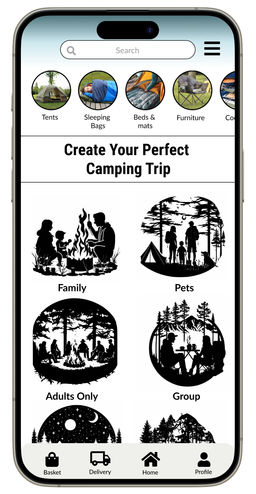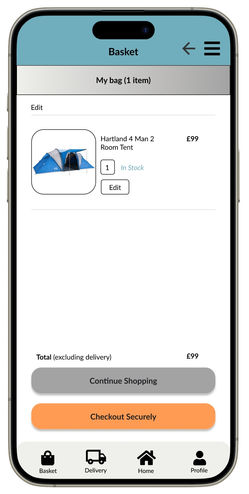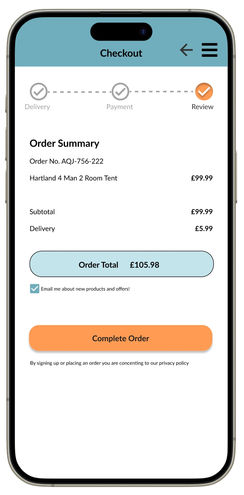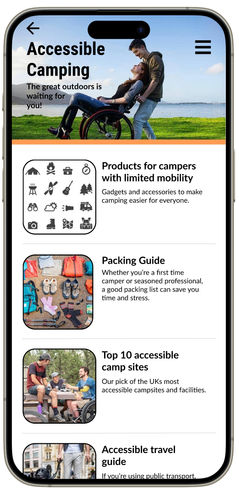
PROJECT OVERVIEW
I designed an app for a camping supply store that not only showcases its products but also guides users toward their ideal outdoor experience. The app provides curated inspiration, expert advice, and personalised product recommendations tailored to a wide range of camping styles and needs. By exploring six distinct camping scenarios, ranging from family-friendly getaways to solo wilderness adventures, users can discover gear and guidance that align with their preferences, enabling them to plan with confidence.
Role
UX/UI Design
Responsibilities
Date
User Research, Wireframing and Prototyping
January - May 2024
The Problem
As users can not physically see and touch the products they are shopping for they lack confidence and sometimes inspiration to create a camping trip that fits their needs.
The Goal
-
Increase user satisfaction by understanding common challenges people face when trying to find the items they need for a camping trip.
-
Increase conversion rates by identifying frustrations people experience during the process of ordering camping supplies online.
UNDERSTANDING THE USER
User Research Summary
-
To understand the pain points of using a camping equipment app or website, I ran a moderated research study of fifteen participants.
-
Target participants characteristics were that they lived in the UK, were 16-55 and went camping at least twice a year.
-
Although most users who camp regularly are between 16 and 34, I wanted to extend the age range to explore the needs of older campers as they are a growing demographic.
-
Although more men than women go camping, I have included equal numbers in the study to better understand female camping needs.
-
I have also included two participants who have increased accessibility needs as this is a limiting factor at many campsites.
Pain Points
Using empathy maps I identified the most common user pain points.
01
Very functional and price focused websites
Many camping equipment websites lead with sale or discount banners in bold colours making this the focus.
02
Little or no inspiration
With a product focus, users who are looking for inspiration and advice are left wanting.
03
Difficult to compare products
The detail on products often differ making it difficult to directly compare and narrow down users choice.
04
Lack of trust without seeing the product in-store
With large purchases such as tents there are concerns about not physically seeing it before purchase.
05
Fear that returning large items will be difficult
The bigger the item the more users worry that it will be inconvenient to return an item.
06
No option for free delivery
When spending over £30 users feel they deserve free delivery.
07
Not sure what to buy
There is a lack of inspiration and ideas on most camping sites and a lack of lifestyle imagery.
08
Poor follow up customer care
With large ticket purchases users need to feel confident that refunds and returns will be simple to process.
Personas
I developed three personas based on user interviews.

Mark Jordan
Mark has been a tennis coach for five years and enjoys helping people to get fit and reach their potential. He also coaches kids for free at the weekend at his local park. Mark lives with his girlfriend and their dog, Muffin. They’re happy in their rented flat but are saving for a house of their own. They love London but enjoy getting out of the city and into nature as much as possible. They like wild camping most as it gives them a sense of freedom, and would like to get away more often. Since they don’t have a car they usually travel by train or hire a car for the weekend for their trips.
Age:
Education:
Location:
Family:
Occupation:
27
Degree, sports science
Wimbledon, London
Lives with girlfriend
Tennis coach
“Stop waiting for things to fall into your lap, go out and make them happen”
Goals
-
Using tennis to help people get fit and learn a skill.
-
Getting people involved in a positive, sporting community.
-
Buying his own house
-
Collecting experiences rather than things
Frustrations
-
He wants to be able to get away from the city and recharge his batteries more often.
-
He loves travelling but hates packing.
-
Camping gear is often heavy and cumbersome.
Problem statement
Mark is a busy tennis coach, who needs a faster more convenient app/website to select the right equipment for wild camping, because he wants a tent that is light enough to carry on the train and easy to pack.
User Journey Map
Mapping out the flow of Marks journey revealed the benefits of creating an app and website for users who want to be able to compare the functionality and specifications of equipment more easily before ordering them.

Amanda Murray
Amanda has been a beautician since graduating college. She likes to stay informed of the latest beauty trends and techniques, so enjoys undertaking additional training. Her husband Paul is a project manager and often works long hours, so after work Amanda usually takes her children, Isabel (age 10) and Grey (age 7), to their clubs.
She is interested in living more sustainably and is conscious of how much plastic they use and the carbon footprint they produce. Amanda loves her job but feels like they’re always rushing around. She would like to spend more quality time as a family and make lasting memories.
Age:
Education:
Location:
Family:
Occupation:
38
Level 3 diploma in Beauty Therapy
Ealing, London
Married with 2 children
Beautician
“Personal care is more than skin deep, it soothes the soul”
Goals
-
To spend more quality time as a family and make memories.
-
To get the kids away from their devices and out into the fresh air.
-
To have more time for herself.
-
To have more disposable income.
Frustrations
-
Finds holidays are expensive.
-
She still worries that Covid is around.
-
She finds it difficult to find activities that the whole family enjoys.
-
Worried that life is passing them by, and the kids are growing up so fast.
-
Annoyed by how difficult it is to recycle properly when you're camping.
Problem statement
Amanda is a business owner and working mum, who needs an app/website where she can plan a family camping trip that is more fun and comfortable than their previous trips. She wants an affordable holiday with her family where they can make wonderful memories together.
User Journey Map
Mapping out the flow of Amanda’s journey revealed that she needs a lot of inspiration and practical advice. She also needs to get everything delivered when she’s at home and hasn’t got time to take returns back to store.
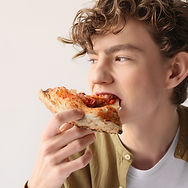
Josh Fielding
Josh is a full time student who loves gaming and taking part in wheelchair basketball. He has been in a wheelchair for two years and his condition also affects his balance and sight but he doesn’t let that stop him enjoying the things that he loves. Josh has been camping with his family several times but wants to plan a trip his summer with his uni friends. He wants to plan ahead so he can concentrate on having fun once he’s there.
Age:
Education:
Home Town:
Family:
Occupation:
21
Studying Computer Science
Leicester
Mum, Dad and Brother
Student
“Don’t let anyone tell you that you can’t do it, because you can!”
Goals
-
Relaxing and having fun with his friends.
-
Still enjoying something he has always loved.
-
Feeling just like everyone else.
-
Spending time in nature
-
Taking a break from uni work.
-
Exploring and feeling free.
Frustrations
-
Campsites with no wheelchair access to the toilet and shower block.
-
Heavy tent poles and tents that are big enough but too low to the ground for him to fit in.
-
Camping stoves with short legs.
-
Not being able to book a pitch that isn’t too far from facilities.
Problem statement
Josh is a fun-loving student, who needs an app/website to help him plan an accessible camping trip and source specialist equipment that will make his life easier while he’s away. He wants to be independent and enjoy the outdoors with his friends.
User Journey Map
Mapping out the flow of Josh’s journey revealed that he needs help to plan his trip and access to tools that will enable him to be as independent as possible while he’s camping.
Secondary Research
I used secondary research to expand my understanding of the project area and identify under-represented groups and opportunity areas:
-
25-34 year olds camp most often.
-
16-24 year olds are the second-largest demographic.
-
Almost 19% of over 55's go camping.
-
Millennials account for 56% of campers.
-
Londoners are the most avid campers.
-
75% of campers go for three nights or more.
-
Ten is the average age for a first camping trip.
-
Over 40% of men and over 63% of women have never camped.
Competitive Audit
I then completed a competitive audit of direct and indirect competitors to identify their strengths and weaknesses.
DEFINING THE SOLUTION

Goal Statement
Our camping store app and website will let users tailor-make a camping trip that is as unique as they are. This will affect all users planning a camping trip by providing inspiration, advice and the products that are right for them.
Idea Generation
I used 'How might we...', crazy eights and rapid sketching to ideate ideas from Mark, Amanda and Josh's problem statements. Many of these ideas could be clustered into inspiration, planning, and delivery and aftercare.
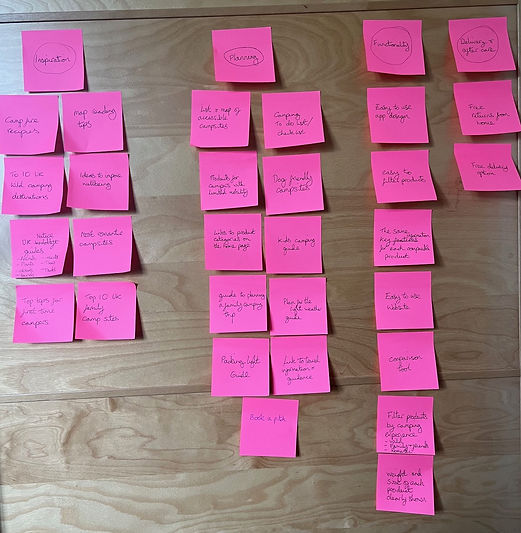
STARTING THE DESIGN
Paper Wireframes
Home screen ideas
Digital Wireframes
Home screen: Designed to encourage two user flows – product and camping experience.
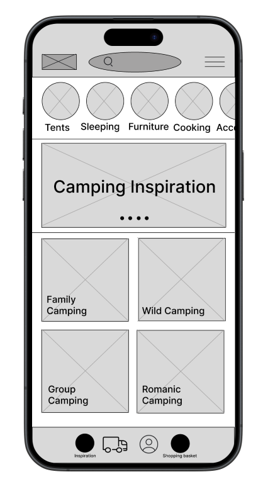
Equipment catagories at the top to quickly access product if you know what you want.
Camping Inspiration will also take users to the experience categories.
Camping experience caragories will guide users to a section of interest to them.
Experience screen: Shopping by camping experience will provide users with practical, tailored information and create a point of difference with our competitors.
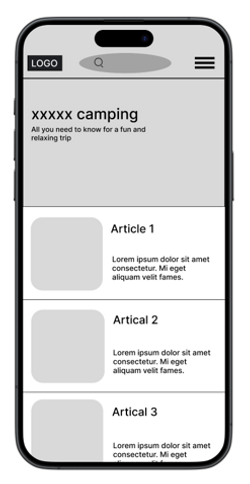
Inspirational lifestyle visuals from the category that has been chosen, i.e. Family Camping.
After the articles there will be a link to curated product for that category.
Family Camping would have articles such as:
•Top 10 family camp sites
•Guide to planning your trip
•Kids camping guide.
User Flow
User Task: Find inspiration and products for a camping trip that is as unique as I am.
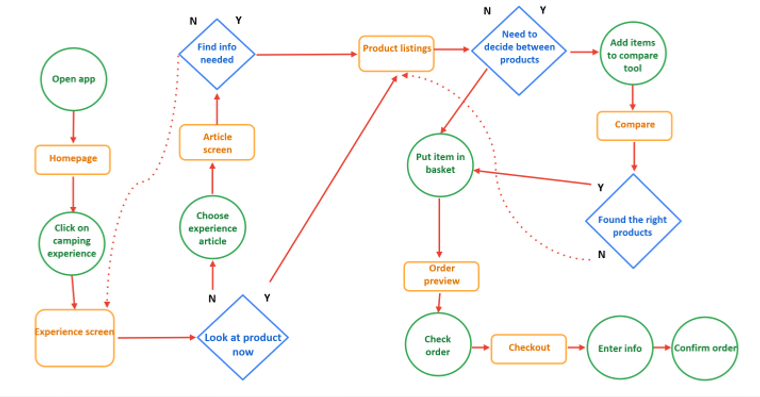
Low-Fidelity Prototype

To view the prototype click here
Usability Study Findings
Round 1: I interviewed five users as part of a moderated usability study - 1st April 2024.
The app was well-received with the users unanimously rating all the tasks we set as easy to complete.
01
Users need improved functionality of the compare tool so they can move easily between the product details screen and the compare tool screen.
02
An adult-only camping experience would be more inclusive than a romantic camping option.
03
Users need improved cues to find their way to the Inspiration section.
04
Users would like to filter products by number of users.
05
The checkout process can be improved.
REFINING THE DESIGN
01
Improve the functionality of the compare tool
Users need to be able to move easily between the product details screen and the compare tool screen.
A table approach may be easier to read.
Before usability study 1
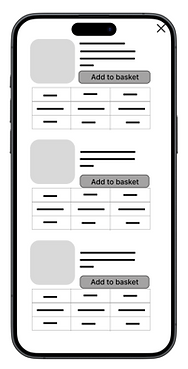
After usability study 1
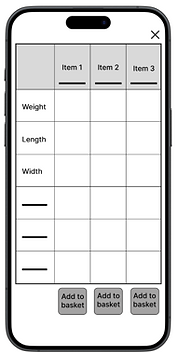
02
Change the Romantic Camping category to Adult-Only Camping, so it is more inclusive.
There are many adult-only camp sites that would appeal to a wider audience than those on a romantic break.

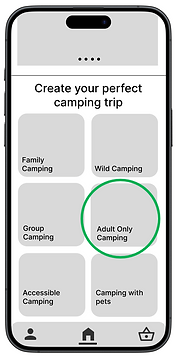
03
Improved cues to the inspiration section.
The light bulb on the bottom navigation bar was not recognised as the icon for inspiration by most of the research participants so should be removed.
The home screen should be simplified to two main user flows:
a) Product
b) Type of camping trip
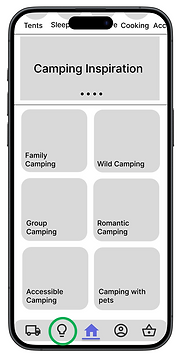
Scrolling images will no longer link to the experience content
Simplified bottom navigation bar
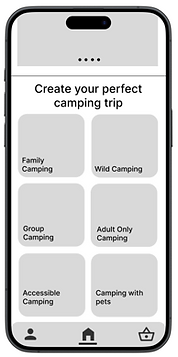
04
Add a menu overlay so users can filter products by number of users.
Only users shopping for tents will need this functionality.

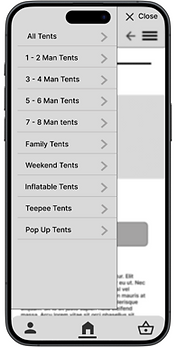
05
The checkout process can be improved
The checkout process needs to be made clearer with the opportunity for the user to review their order a second time at the end of the checkout process before completing it.
Split the process into:
a) Delivery
b) Payment
c) Review
d) Confirmation
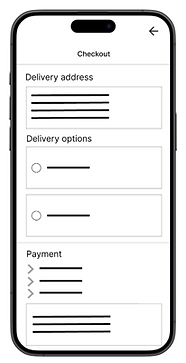
First checkout screen
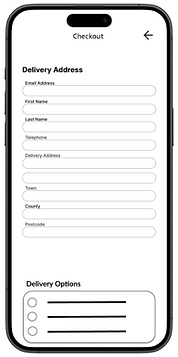
Hi Fi Mock-ups
Inspiration Flow
Product Flow
Additional Camping Experience Screens
Hi-Fidelity Prototype
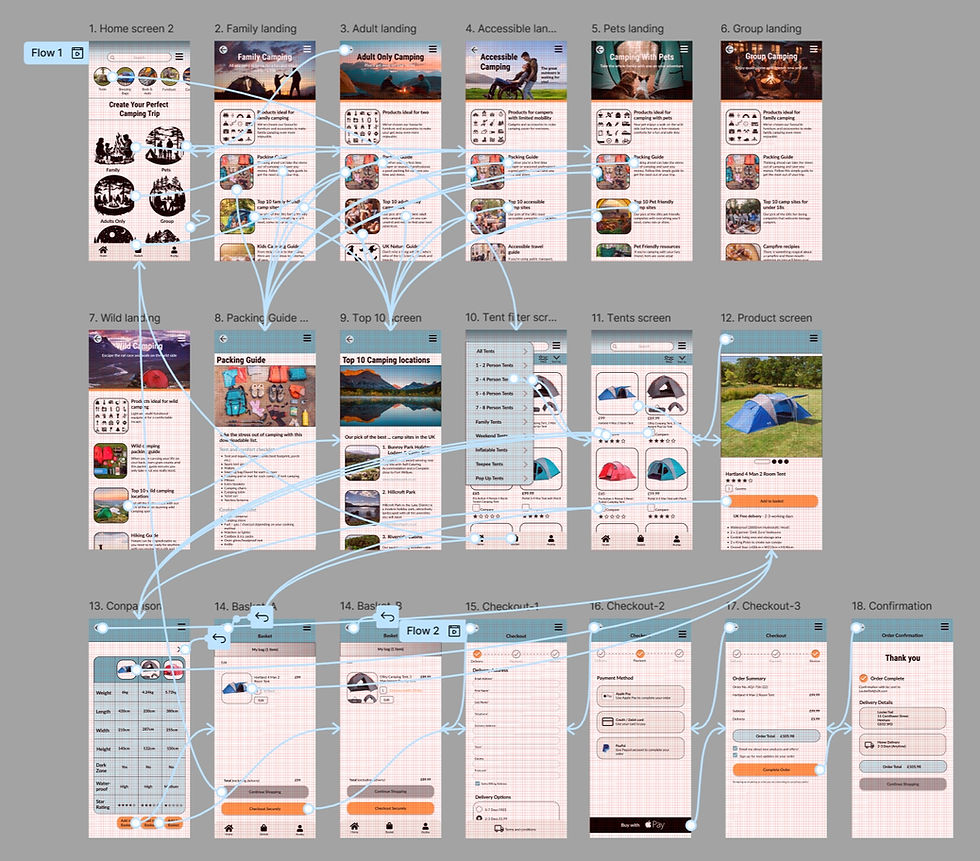
Accessibility Considerations
01
Code for use with a screen reader such as VoiceOver.
88% of users who rely on screen readers are between 21-40 and our target users.
- Alt Text for images
- Clear page titles
- Form field labels
02
High Contrast
Body copy is back on white or pale blue for maximum contrast.
Header copy only appears over images on the inspiration screens and here white or black is selected to maintain contrast.
Orange action buttons
03
CVD friendly colour palette
Blue and orange can clearly be distinguished by users with colour vision deficiency
(4.5% of adults on the UK).
Additional differenciation has been achieved by reducing the saturation of the pale blue.
Usability Study Findings
Round 2: I interviewed five users as part of a moderated usability study – 5th June 2024.
The app was very well received and only small adjustments required.
01
Users need to find the back arrow in a consistant location
02
Users expect to find the home icon on the left of the navigation bar
03
The delivery icon is not required on the navigation bar and delivery information can be shown in the menu instead.
04
Some users didn’t understand that the number on the product page indicates quantity, so a label needs to be added. This will also improve accessibility.
05
It would be appreciated if the image carousels could travel in a loop and returned the user to the first image.
06
Tents should be referred to as ‘berth’ or ‘person’ but not ‘man’.
01
Location for the back arrow
Move the back arrow to the left and create a consistent location and highlight for ease of navigation.
Before usability study 2
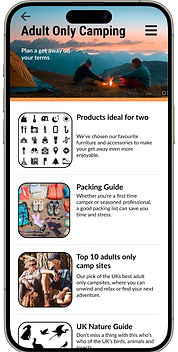

After usability study 2


02
Move and delivery icons
Move Home Icon to the left
Remove the delivery icon


03
Product detail screen
Add a label to the quantity box and
loop the carousel to return to the first image
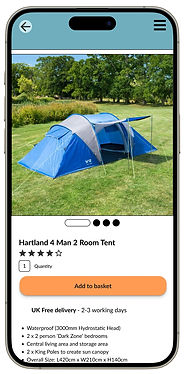
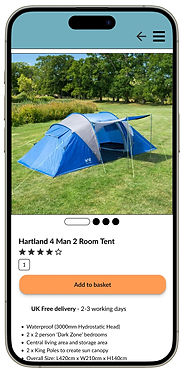
04
Product drop-down
Change ‘Man’ to ‘Person’ when describing the capacity of tents.


Sticker Sheet

GOING FORWARD
The Impact
The development and launch of this camping app could make significant strides in enhancing the outdoor experience for camping enthusiasts across the UK. This innovative application offers a comprehensive platform that connects campers with valuable resources, ensuring a more enjoyable and personalised outdoor adventure.
-
Increase in User Base: By providing guidance to users based on the camping experience they want to create, this app makes a departure away from the purely practical camping retailer content, towards the extremely lucrative experience market.
-
User Retention: By continuing to build on the seasonal content and inspiration on the app, it will maintain engagement with our user base so Camping Collective are front of mind when they come to make their next purchase.
What I Learned
Reflecting on my first UX project, there are a number of key takeaways that stand out:
-
User Centred Design is crucial: One of the most important lessons from this project is that the user’s needs and preferences should drive every decision. I quickly learned that understanding your target audience through research and empathy mapping is vital to creating a product that truly resonates with them.
-
The power of Prototyping and Testing: I discovered how essential it is to prototype and test your designs iteratively. Building prototypes, conducting usability tests, and gathering feedback helped me identify usability issues early, saving time and resources in the long run.
-
The importance of adaptability: No project ever goes perfectly according to plan. I learned the importance of being flexible, whether it’s pivoting based on user feedback or handling unexpected challenges.
-
Attention to detail and consistency: I now fully recognise the importance of maintaining a consistent design language and paying attention to the smallest details. This helps in creating a seamless and intuitive user experience. A sticker sheet helped me save time across the project and I will develop on this into design systems in the future.
-
Continuous learning and improvement: Finally, I have realised that UX design is an ongoing process. Even after the project is “completed,” there’s always room for improvement based on user feedback and evolving user needs.

01.
Design the remaining screens for a fully operational prototype:
-
Menu
-
‘Ideal products’ pages for each camping experience.
-
Specific camping guides i.e. kids and nature.
02.
Another round of user research to check the last iterations to the hi-fi prototype
03.
Make final changes based on user research and in the real world get stake holder sign off to move to the next stage.




